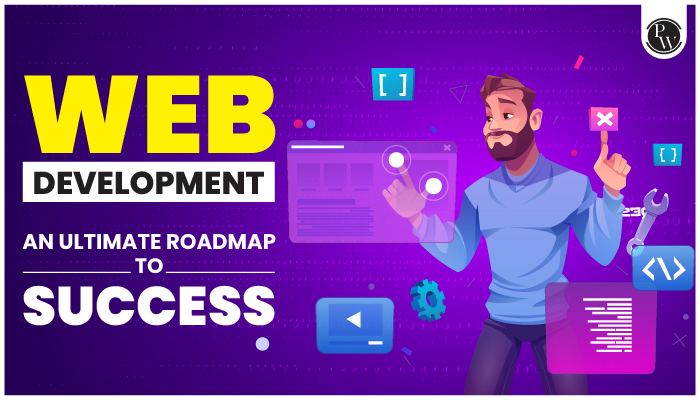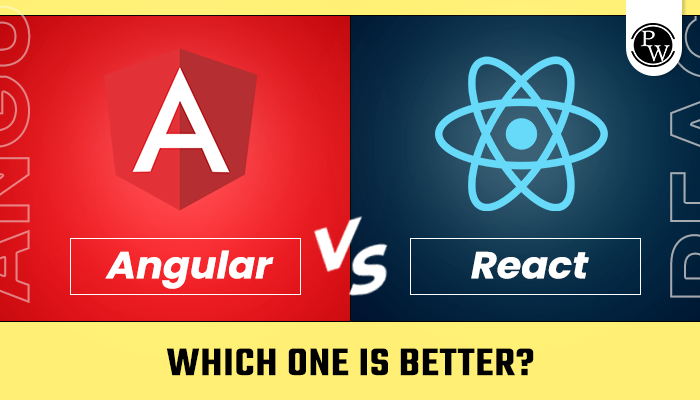Back-end web programming is among the most crucial parts of web development. Without the back-end, it’s impossible to make a website work properly. So, here’s everything you need to know about it!
Back-End Web Programming: Back-end web programming is the engine powering the seamless functionality of websites and applications. Hidden backstage, it oversees databases, handles requests, and safeguards data integrity. Using languages like Python, Ruby, or Node.js, back-end developers craft the logic that brings your favourite blogs to life.

They implement user authentication, handle server-side operations, and connect your front-end interface with dynamic content. It’s the silent champion turning still web pages into dynamic interactions. In this blog, we’ll talk about back-end web programming, Back-end web programming examples, back-end web programming languages, and much more!
If you’re looking for the best Full Stack Web Development course in 2024, then PhysicsWallah’s Full Stack Development course is just what you’re looking for! Our course will teach you everything you need to know as a web developer for success in 2024! So, don’t wait, use the coupon code – READER and get an exclusive discount on all course from PW Skills.
What is the Back End of Web Development?
In web development, the back end refers to the server-side of a website or web application. It encompasses the technologies, databases, and server processes that work behind the scenes to deliver and manage data, ensuring the functionality and performance of the entire system.
The back end is responsible for processing and storing information, handling user requests, and ensuring that the front end (user interface) can interact seamlessly with dynamic content.
Key components of the back end include:
- Server: At the core of the back end is the server, a powerful computer that stores and manages the resources needed to run a website or application. Servers react to user requests, carry out tasks, and interact with databases.
- Database: Information such as user profiles, content, and settings are stored in databases. Common types of databases include MySQL, PostgreSQL, MongoDB, and others. Back-end developers design and implement database structures, ensuring efficient storage and retrieval of data.
- Server-Side Scripting: Back-end development involves using server-side scripting languages like Python, Ruby, PHP, or Node.js. These languages enable developers to create dynamic and interactive features, handle user input, and generate content dynamically based on specific conditions or user actions.
- APIs (Application Programming Interfaces): APIs allow different software components to communicate and interact with each other. IIn web development, APIs play a vital role in linking the front end to the back end. They define the rules for how software components should interact, enabling seamless integration of services and data.
- Frameworks: Back-end developers often leverage frameworks, which are pre-built structures that provide a foundation for building applications. Popular back-end frameworks include Django (Python), Ruby on Rails (Ruby), Express.js (Node.js), and Laravel (PHP). These frameworks streamline development, enforce best practices, and enhance the overall efficiency of the back-end coding process.
- Security: Back-end development plays a critical role in ensuring the security of web applications. This involves implementing measures such as encryption, authentication, and authorization to protect sensitive data and prevent unauthorised access or attacks.
- Server-Side Logic: The back end is responsible for implementing the business logic of an application. This includes processing user input, handling authentication and authorization, managing sessions, and performing various operations to deliver a dynamic and personalised user experience.
The back end is the engine that powers the entire web development process. It focuses on the server-side processes, databases, and server logic necessary to store, process, and deliver data to the front end. Back-end developers collaborate with front-end developers to create fully functional, secure, and dynamic web applications that meet the needs of users and businesses alike.
What is an Example of a Back End in Web Developer?
An example of a back-end component in web development is a user authentication system. Let’s break down the process and highlight the back-end elements involved:
- User Registration:
-
-
- Front End: A user interacts with a registration form on the website, entering their desired username, email, and password.
- Back End: The back-end server receives the form data through an HTTP request. Using server-side scripting (e.g., with a language like Python or PHP), the back end processes the information.
-
- Database Interaction:
-
-
- Back End: The back end communicates with a database (e.g., MySQL or MongoDB) to store the user’s information securely. This involves creating a new user record in the database, encrypting the password, and associating it with the provided username and email.
-
- User Authentication:
-
-
- Front End: After registration, the user attempts to log in using their credentials.
- Back End: The back end receives the login request, retrieves the user’s stored information from the database, and verifies the entered password against the stored, encrypted version. If the credentials match, the back end generates a secure session token.
-
- Session Management:
-
-
- Back End: The server manages user sessions, keeping track of authenticated users. The session token, typically stored as a cookie or in the browser’s local storage, is used to recognize the user across different pages and requests.
-
- Authorization:
-
-
- Front End: As the user navigates through the website, they may attempt to access certain pages or features.
- Back End: The back end checks the user’s session token with each request to ensure they are authenticated. Additionally, it may implement authorization logic to determine if the user has the required permissions to access specific resources.
-
- Security Measures:
-
- Back End: To enhance security, the back end implements measures such as password hashing (to protect stored passwords), encryption (for sensitive data transmission), and possibly rate limiting or CAPTCHA to prevent brute force attacks.
In this example, the back end handles the critical aspects of user registration, authentication, and authorization. It interacts with the database to securely store user information and manages user sessions to ensure a seamless and secure user experience. The collaboration between the front end and back end results in a robust and user-friendly authentication system for the web application.
Also Read: Back End Web Dev Tutorial: Salary, Roles and Responsibilities
Which language for Backend Development?
Choosing a language for backend development is a crucial decision that depends on various factors, including project requirements, developer expertise, and the desired features of the web application. Here, we’ll discuss several popular backend programming languages, each with its strengths and use cases.
- JavaScript (Node.js): JavaScript has gained significant popularity for full-stack development, thanks to Node.js. It allows developers to use the same language on both the front end and back end, promoting code reusability. Node.js is known for its event-driven, non-blocking I/O model, making it suitable for handling a large number of simultaneous connections.
- Python: Python is renowned for its readability and simplicity. It has a vast ecosystem of libraries and frameworks, such as Django and Flask, that facilitate rapid development. Python is widely used for web development, data analysis, machine learning, and more. Django, in particular, provides a high-level framework for building robust and scalable web applications.
- Ruby: Ruby, combined with the Ruby on Rails framework, emphasises convention over configuration, enabling developers to write less code for common tasks. Ruby on Rails is known for its developer-friendly environment, promoting the use of best practices and speeding up the development process.
- Java: Java has been a stalwart in enterprise-level applications for many years. It is known for its portability, scalability, and strong community support. Java-based frameworks like Spring provide a comprehensive solution for building large-scale, mission-critical applications.
- PHP: PHP has long been a cornerstone of web development, powering a significant portion of the web. It is known for its simplicity, ease of integration, and low learning curve. PHP frameworks like Laravel and Symfony enhance development speed and maintainability.
- C# (ASP.NET): C# is commonly associated with Microsoft’s ASP.NET framework. It is widely used for building robust web applications, especially in the Windows environment. ASP.NET provides a comprehensive set of tools for building scalable and secure applications.
When deciding on a backend language, consider the following factors:
- Project Requirements: Different languages excel in different domains. Python is great for data science and artificial intelligence, while Node.js is well-suited for real-time applications. Choose a language that aligns with your project’s specific needs.
- Developer Skill Set: Assess the expertise of your development team. Choosing a language they are familiar with can significantly impact development speed and code quality.
- Community Support: A strong and active community ensures ongoing support, updates, and a wealth of resources. Consider the size and engagement of the community around the language you choose.
- Scalability and Performance: Evaluate the scalability requirements of your application. Some languages and frameworks are better suited for handling large-scale applications and high traffic.
The choice of a backend language depends on a combination of technical requirements, project scope, and developer preferences. Each language mentioned here has proven its effectiveness in various scenarios, so it’s essential to weigh the pros and cons based on the specific needs of your web development project.
What is Back End in Computer Programming?
In computer programming, the term “back end” generally refers to the part of a software system or application that is responsible for handling tasks that are not directly visible or interacted with by end-users. It contrasts with the “front end,” which is the part of the system that users directly interact with, such as the user interface.
The back end focuses on the server-side logic, data processing, and storage. Here are key aspects that differentiate the back end from the front end in computer programming:
- Server-Side Logic:
-
-
- Back End: It deals with the server-side logic and functionality of an application. This includes processing requests, handling business logic, and managing data operations.
- Front End: The front end is concerned with the presentation and user interface. It interprets and displays data received from the back end, creating the user experience.
-
- Data Processing and Storage:
-
-
- Back End: The back end manages the storage and retrieval of data. It interacts with databases, processes information, and ensures data integrity and security.
- Front End: While the front end may cache and display data, the actual processing and storage occur on the back end. Front-end components typically request data from the back end through APIs (Application Programming Interfaces).
-
- Server-Side Languages and Frameworks:
-
-
- Back End: Back-end development involves using programming languages like Python, Java, Ruby, PHP, or JavaScript (Node.js) along with frameworks like Django, Spring, Ruby on Rails, Laravel, or Express.js.
- Front End: Front-end development uses languages like HTML, CSS, and JavaScript, along with frameworks like React, Angular, or Vue.js for creating interactive user interfaces.
-
- User Authentication and Authorization:
-
-
- Back End: Authentication processes, user management, and authorization are typically handled by the back end. It ensures that users have the necessary permissions to access certain resources.
- Front End: The front end may provide the user interface for login and authentication, but the actual validation and authorization checks occur on the back end.
-
- Security Measures:
-
- Back End: Security measures such as encryption, secure data transmission, and protection against common web vulnerabilities (e.g., SQL injection, cross-site scripting) are implemented on the back end.
- Front End: While the front end may handle some security aspects, the back end is primarily responsible for securing data and preventing unauthorised access.
Recommended Technical Course
- Full Stack Development Course
- Generative AI Course
- DSA C++ Course
- Java+DSA 1.0 Course
- Data Analytics Course
- Data Science with ML 1.0 Course
- Free Backend Development Course
How to Become a Back-End Developer?
There are many paths you can take to become a web developer. Whether you are a recent graduate or hoping to switch careers, it is important to assess what transferable skills you already have and consider building the new skills needed to pursue a back-end developer role.
Back-end developer technical skills
As someone working on the back-end of development, you’ll need to acquire specific technical skills to handle the creation of the back-end for web or mobile applications.
- Programming languages: Every back-end developer should have a good command of back-end programming languages like Python, Java, and PHP. These languages play a crucial role in enabling websites to function seamlessly when integrated with databases, frameworks, and servers. Python, in particular, stands out as a highly popular programming language due to its compatibility with artificial intelligence (AI) and machine learning, and its ability to facilitate the creation of clear and logical code. Additionally, having a basic understanding of front-end languages such as HTML, CSS, and JavaScript is an added advantage.
- Frameworks: Frameworks serve as the libraries for back-end programming languages, assisting in the construction of server configurations. They are typically associated with specific programming languages; for instance, if you are acquainted with Python, you’ll likely be familiar with frameworks like Flask, Django, or other Python-based frameworks.
- Databases and servers: A crucial aspect of back-end programming involves comprehending the stacking and retrieval of data from databases. Back-end programming governs the access, storage, and recovery of information. Popular database programs like MongoDB and MySQL are commonly utilised for this purpose. The database functions as a storage system, organising client data for easy arrangement and retrieval, akin to using cloud storage for your photos. Subsequently, this database operates on a server, delivering data as requested.
- Application Program Interface (API): An API consists of guidelines and regulations for creating application software. Besides creating websites for internet browsers, companies frequently desire a mobile app compatible with iOS or Android. Having familiarity with programming languages such as JavaScript can broaden your employment prospects.
- Accessibility and security clearance: It’s important to gain understanding in network protocols and web security for your development journey. Ensuring the security of databases and servers will play a crucial role in achieving success as a back-end developer.
If you have an interest in cloud technology, you might want to join IBM’s Full-Stack Cloud Developer professional certificate program to explore a wide range of cloud-specific technologies.
With guidance from IBM experts, you will acquire skills in building applications for the cloud, comprehend front-end languages such as HTML and CSS, and gain knowledge in back-end languages and frameworks like Express, Node.js, Python, and Django, among other essential topics. These are fundamental skills that can be valuable whether or not you choose to pursue roles related to the cloud.
Back-end web programming serves as the engine behind seamless blog functionality. It orchestrates data storage, retrieval, and processing, ensuring a dynamic and responsive user experience. From managing databases to handling server-side logic, the back end empowers the blog to deliver content efficiently.
Security measures, like user authentication, bolster the integrity of user data. As a crucial component of web development, back-end programming lays the foundation for a robust and scalable blog, harmonising various elements to create a cohesive and reliable digital platform. Its significance lies in optimising performance, enhancing user interactivity, and maintaining the overall integrity of the blog’s architecture.
For Latest Tech Related Information, Join Our Official Free Telegram Group : PW Skills Telegram Group
Back End Web Programming FAQs
What is Back-End Web Programming?
Back-End Web Programming involves developing server-side logic and functionalities that power the functionality and data management of a website, ensuring smooth user experiences.
Which languages are commonly used in Back End Web Development?
Popular back-end languages include Python, PHP, Ruby, Java, and Node.js, each offering unique features and capabilities to handle server-side operations.
Why is the Back End crucial for web applications?
The Back End is essential for managing data, handling user authentication, and executing server-side processes, ensuring the seamless functioning of web applications and enabling dynamic content delivery.
What is the role of a database in Back End Web Development?
Databases store and retrieve data for web applications, allowing Back End developers to manage and organise information efficiently, enhancing the overall performance and responsiveness of a website.
How does Back End differ from Front End development?
While the Front End focuses on the user interface and client-side interactions, Back End development deals with server-side logic, databases, and application architecture, ensuring the functionality and data management behind the scenes.



